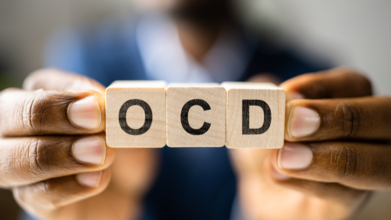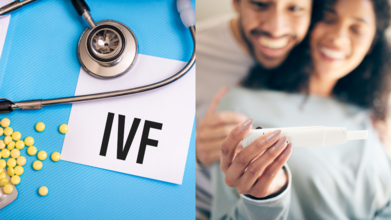- Health Conditions A-Z
- Health & Wellness
- Nutrition
- Fitness
- Health News
- Ayurveda
- Videos
- Medicine A-Z
- Parenting
- Web Stories
Ohio Woman’s Routine Manicure ‘Saved Her Life’- How A Nail Discoloration Turned Out To Be Skin Cancer?

Image Credits: Kennedy News & Media
A regular manicure became a lifesaver for 58-year-old Michelle Tagliamonte of Centreville, Ohio. What appeared to be a minor cosmetic issue—a strange black line on her thumbnail—proved to be an early warning sign of melanoma, one of the most dangerous types of skin cancer. Her experience highlights the value of being attentive to changes in your body and seeking medical advice when things do not feel right.
Tagliamonte, like many others, had a regular beauty routine. She visited a nail salon every four weeks for a manicure, a routine she followed without much thought. Yet, at the time of her last September visit, she noticed something odd—thin black lines on her right thumbnail. She initially dismissed it, thinking that nothing was wrong.
"I typically get my nails done every four weeks, so I don't know how long it had been there," she remembered. "But my nails grow pretty quickly because I have really good nutrition. It could have been there for six months or longer."
She snapped photos of the lines and went on with her nail appointment, unaware that this apparently insignificant detail was an indicator of something much more severe.
As the weeks went by, Tagliamonte observed that the lines did not extend out with her nail as she had anticipated. Rather, they stuck at the base of her thumbnail and appeared to be getting deeper. By the time her next appointment arrived, the marks persisted—unchanged and unerased.
That was the wake-up call. Not taking any chances, she went to see a doctor. Over Thanksgiving, the results revealed her worst fears—the black lines were evidence of melanoma, stage zero or 'melanoma in situ.'
What is Stage Zero Melanoma?
Stage zero melanoma, or 'melanoma in situ,' is a situation where the cancer cells remain in the epidermis and have not extended beyond it. Although it is the most treatable and earliest stage, it can become invasive melanoma, spreading to other regions of the body and threatening life, if it goes undiagnosed.
Physicians moved quickly to eliminate the cancerous cells before they had a chance to disperse. On January 17, Tagliamonte received a four-hour surgical procedure in which physicians amputated her entire thumbnail. To reattach the damaged area, a skin graft was conducted using tissue from the rest of her thumb.
The dermatologist noticed discoloration at the bottom of my nail," she said. "Whatever was producing this black line was originating from within the growth plate, way down deep inside my nail.
The procedure was invasive and complicated. The melanoma extended down to the first knuckle of her thumb, and a considerable amount of tissue had to be removed. The exposed bone and tendon were covered with the skin graft to allow the area to heal. Although she permanently lost her thumbnail, Tagliamonte is thankful for the timely medical intervention that left her alive.
Tagliamonte attributes her routine manicure sessions and her own vigilance for detecting the disease before it advanced to a more serious phase.
"The nail appointment definitely saved my life," she stressed. "I am thankful that I noticed it and then went about having it checked out."
Her experience is an eye-opener that even slightest changes in the body, whether seemingly innocuous, can prove to be signals of major illness at times. She now prefers others to be alert and hearken to instincts.
If you notice something unusual or different, listen to your own instincts and have it looked at," she warned. "If I'd have ignored it, Lord only knows what might have happened to me in the future."
Hidden Dangers of Nail Health and Exposure to the Sun
Tagliamonte's account also makes one mindful of other health hazards of nail care. Numerous individuals are not aware that dark or black stripes in the nails can be markers of hidden underlying medical conditions. At times, such markings could be a consequence of a disorder known as subungual melanoma, an infrequent yet malignant form of skin cancer beneath the nail.
Moreover, experts caution against the dangers posed by the UV lamps that are employed in certain professional manicures to harden gel nail polish. Such machines release UVA rays, which penetrate deep into the skin, heightening the risk of skin cancer with extended exposure.
"Too much exposure to UV light can harm the DNA of skin cells, causing them to grow out of control and form tumors," say dermatologists. "UVA and UVB radiation both help cause skin cancer, though UVB is more directly responsible for sunburn, with UVA causing more long-term harm and hastening the skin's aging process."
Uncommon Signs of Melanoma
Although melanoma is usually linked to moles and skin lesions, Michelle Tagliamonte's situation featured a number of uncommon warning signs:
Black Stripes on the Nail – Rather than a visible skin lesion, she saw dark stripes along her thumbnail, a less common symptom of subungual melanoma.
No Discomfort or Pain – Most people expect cancerous tumors to be painful, but Michelle felt no pain, making the diagnosis even more surprising.
Slow and Steady Growth – The streaks did not fall out or simply grow out with her nail, an indication that there was something amiss.
Concealed Source – The melanoma was growing from the growth plate of the nail underneath, hence hidden at first.
Stage Zero Diagnosis – Despite the alarming signs, the melanoma was actually in its earliest stage, illustrating how intervention at this point could avoid fatal effects.
Microstress Is Real: These Tiny Terrors Are Quietly Wrecking Your Mental Health

We often associate stress with dramatic breakdowns, overwhelming work, or emotional turmoil. But what if the real danger lies in the tiny, everyday pressures we don’t even notice building up?
What Is Microstress and Why It Matters
“Stress is the most notorious yet underplayed disease,” says Alma Chopra, motivational speaker, disability rights activist and life coach. “It’s often thought of as an emotional onslaught that makes it difficult to function. But stress isn't just limited to our emotions; we can also become physically stressed from a chronic illness or an injury.”
Alma explains that microstresses are small, fleeting moments of stress that sneak into our daily routines. “Sometimes it creeps up through daily pressures until we hit our melting point. These are called microstresses,” she shares. These could include running late for a meeting or scrolling social media right after waking up. They may feel harmless in the moment but layer up to become chronic stress over time.
How Microstresses Mess With You
“These reactions feel minor and temporary, so they're quickly replaced by the next task or eased by a smiling face or a piece of cake,” says Alma. But the danger lies in how these minor stressors build up over time. “We tend to ignore these micro-stresses, but over time, they build low-level tension that will affect your sleep, focus, mood and health.”
Alma lists common microstressors and their effects:
- Alarm: “Jerks the body into a sudden state of alertness, disrupting natural rest.”
- Checking work email: “Doing this first thing in the morning puts us into a state of panic and anxiety.”
- Scrolling social media: “Overstimulates the brain and drains mental focus.”
- Confrontations: “Force us to deal with discomfort we’re not emotionally prepared for.”
- Unfinished tasks: “Juggling a long list without breaks builds pressure and leads to burnout.”
- Bruising your knee: “Even minor damage to the bone or soft tissue creates physical stress in the body.”
Alma advises recognising patterns and creating little routines to manage stress before it spirals. “Begin by recognising patterns, checking what drains you and creating little routines to relieve stress,” she says. “Start taking short breaks, creating boundaries and incorporating rejuvenating practices into your day.”
When Lifestyle Fuels Microstress
Sukirti Midha, spiritual wellness coach and founder of Sukh Yog, points out that microstress is a lifestyle issue. “Micro stress, as the name suggests, is small things we face as a working person or a householder. No gender age or designation we are discussing here; it’s the same for all,” she says.
According to Sukirti, “It’s in our lifestyle now; still, we are not aware of it.” She adds that people often don’t even feel it building up. “Do you think it happens overnight? No, nothing happens overnight except the sun comes out,” she jokes, adding a serious note that many people today don’t even see the sunrise, contributing to deficiencies like vitamin D.
Sukirti points out how society’s pressure to look good and maintain appearances feeds microstress. “When one gets conscious about looks, which include not only clothes but also touch-ups, make-up and hair. It’s not social pressure but created by us only.” She questions why people rely on external validation to feel good. “Why is it always important to look good to feel good?”
She also flags social media’s impact. “Many social media applications have filters to make you feel more beautiful and younger, which gives you plenty of stress when we look back in a basic mirror.” Comparing ourselves to others’ curated lives triggers a subtle but ongoing sense of inadequacy.
“Maintaining a status is a pressure these days,” she says. “Always remember as we shift from past to present or future to present, we learn happiness is about you & not the things or society status.”
The Simple Way Out
Both experts agree that while microstress can’t always be avoided, we can manage it better by slowing down, drawing boundaries and valuing simplicity. As Sukirti says, “Staying away from microstress isn’t easy, but preferring solace is an easy way out.”
Loving Perfection and Cleanliness Does Not Mean You Have OCD: Here Is What The Disorder Actually Means

If you have ever colour-coded your wardrobe, wiped the kitchen slabs repeatedly just because a speck of dust exists, or straightened a slightly off-centre painting on the wall, someone has probably laughed and said, I am so OCD too. But the thing is that you are probably not. And neither are they.
Somewhere along the way, we all misunderstood Obsessive Compulsive Disorder (OCD), a serious mental health condition, and casually said it. OCD has become shorthand for being neat, organised, or a lover of clean aesthetics. But as mental health professionals and those who actually live with OCD will tell you, that stereotype could not be further from the truth.
OCD is a clinically diagnosed anxiety disorder. It is not just about being extra clean or a control freak. It involves a cycle of obsessions, which are intrusive, unwanted thoughts and compulsions, which are repetitive behaviours or mental acts done to try to neutralise those thoughts.
Imagine being haunted by a constant fear that your loved one will die unless you tap the light switch exactly five times. Or being plagued by the thought that you have hit someone with your car, even though there is no evidence of it happening, and then going back to the same stretch of road again and again to check. That is the lived reality of OCD. It is not cute, it is not fun, and it definitely does not feel satisfying or neat.
The Cleanliness Myth
Yes, some people with OCD have cleanliness-related compulsions. But not everyone with OCD is a neat freak, and not all neat freaks have OCD. The need to wash your hands repeatedly until they are raw is not about loving cleanliness; it is about desperately trying to get rid of a feeling that something is terribly wrong. Often, the compulsion is not even rationally linked to the obsession. It is about trying to regain control over overwhelming anxiety, even if only temporarily.
In fact, OCD themes can be disturbingly varied, from fears of harming others to taboo thoughts to symmetry to morality. The common thing is that the thoughts are distressing, the anxiety is debilitating, and the rituals are exhausting.
Why It is Harmful To Mislabel Yourself As “OCD”
Calling yourself “OCD” because you like your stuff arranged by colour might seem harmless. But this kind of throwaway comment does a real disservice to people living with the actual condition. It trivialises their experiences and contributes to misinformation.
It also prevents those who might truly be struggling with OCD from recognising their symptoms and seeking help. Because if society keeps painting OCD as a personality problem, why would anyone think it is a serious problem?
What OCD Actually Feels Like
Ask anyone with OCD, and they will tell you it is not fun. It is not satisfying to double-check the lock for the 17th time. It is not enjoyable to feel like you are going to vomit because of a thought you did not ask for and cannot get rid of. It is a relentless loop of “what ifs” and “just in cases” that can take over your entire life.
OCD can interfere with relationships, work, sleep, and basic daily functioning. It is often accompanied by shame and secrecy because people worry others would not understand, or worse, will think they are dangerous or irrational.
Time To Rethink The Label
You might just be tidy. Or meticulous. Or even perfectionistic. And that is fine. But OCD? That is a diagnosis. A tough, often debilitating one that deserves respect. If you think you might actually have OCD, then help is available. Cognitive Behavioural Therapy (CBT), particularly Exposure and Response Prevention (ERP), has been proven to be effective. But it starts with understanding what OCD really is.
World IVF Day: What Makes The IVF Journey So Hard On The Mind?

In vitro fertilisation (IVF) is not just about science, syringes and success rates. What lies behind the walls of fertility clinics is a deeply personal journey filled with hope, heartbreak and resilience, making it more than just a medical procedure. Beyond the social taboos, infertility brings huge stress to the patients. And while IVF offers hope, it does not come easy. It is a rollercoaster ride that patients experience as they take on the road to this procedure; highs and lows can take a severe mental toll on them.
However, for those unversed, infertility has been classified by the World Health Organisation as a disease like diabetes or hypertension; the social taboo around it still persists. Over the years, advancements in reproductive science have made IVF treatments more patient-friendly and significantly improved outcomes. Yet, the focus often leans heavily on science, expertise and clinic proficiency, while the mental and emotional toll on the couple is overlooked.
For many, the psychological impact of IVF can match that of the death of a family member or going through a divorce. Although many people find IVF very stressful, every patient experiences it differently. Personalities and life experiences play a big role in determining how one handles the process and what part of IVF they find most difficult.
Why Is IVF So Emotionally Draining?
We ask an expert to break down several key factors that contribute to the immense stress IVF brings:
- Uncertainty of Outcomes
- Physical Strain
- Societal Pressure
- Guilt and Shame
- Depression After Failed Attempts
- Relationship Strain
Learning to Cope with Support Systems That Help
There is light at the end of the tunnel, and as Dr Saple says, there are several strategies that can help couples better cope with the IVF process.
- Psychological Counselling
- Support Groups
- Mind–Body Practices
Setting Realistic Expectations
“IVF may take more than one cycle to succeed,” she explains. Being mentally prepared for the outcome, while knowing you have done your best, helps couples accept results with resilience.
It is Okay to Ask for Help
As Dr Saple reminds us, mental and emotional health are as important as physical health during IVF. Prioritising emotional wellbeing not only makes the journey more bearable but can also improve the overall outcome. “Seeking help is a sign of strength, not weakness,” she says.
© 2024 Bennett, Coleman & Company Limited

